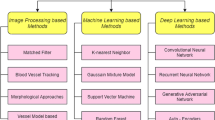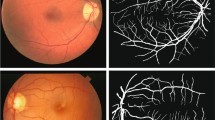Abstract
Retinal vessel segmentation aims to separate the structure of blood vessels from the fundus image background. This retinal vasculature is then used for detection of numerous diseases like retinopathy of prematurity (ROP), glaucoma, diabetic retinopathy, coronary heart disease, etc. Deep learning-based semantic segmentation techniques are considered a breakthrough in the field of medical diagnosis using artificial intelligence. Various methods for segmentation with convolutional neural networks have been developed which have become indispensable in tackling more advanced challenges with image segmentation. The limitation is that they all require huge quantities of labeled data which is difficult to collect. To overcome this, U-Net architecture is widely used for segmentation of medical images as it segments the pixels individually and can be trained with a small number of images. In this work, we have implemented U-Net architecture and evaluated it on two public datasets: ‘HRF’ and ‘DRIVE’. An accuracy of 96.64% was obtained on the DRIVE dataset and 94.28% on HRF dataset. To check the model robustness, we tested the model trained on the augmented DRIVE dataset on the HRF dataset and vice versa. The model trained on the augmented HRF training set achieves an accuracy of 95.04% when tested on the DRIVE dataset. Similarly, the model trained on the augmented DRIVE training set achieves an accuracy of 92.17% when tested on the HRF dataset. A progressive web application is also developed as part of this work, since there is no specific easy-to-use interface to perform segmentation of retinal fundus mentioned in the literature, to the best of our knowledge. This application accepts retinal fundus image as input and performs segmentation using trained U-Net model, to provide an output image of the blood vessels which will assist the ophthalmologists in screening retinopathy.
Access this chapter
Tax calculation will be finalised at checkout
Purchases are for personal use only
Similar content being viewed by others
References
Almotiri J, Elleithy K, Elleithy A (2018) Retinal vessels segmentation techniques and algorithms: a survey. Appl Sci 8(2):155
Saxena R, Singh D, Vashist P (2013) Glaucoma: an emerging peril. Indian J Community Med Off Publ Indian Assoc Prev Soc Med 38(3):135
Jelinek HF, Cree MJ, Leandro JJ, Soares JV, Cesar RM, Luckie A (2007) Automated segmentation of retinal blood vessels and the identification of proliferative diabetic retinopathy. JOSA A 24(5):1448–1456
Franklin SW, Rajan SE (2014) Computerized screening of diabetic retinopathy employing blood vessel segmentation in retinal images. Biocybern Biomed Eng 34(2):117–124
LeCun Y, Boser B, Denker JS, Henderson D, Howard RE, Hubbard W, Jackel LD (1989) Backpropagation applied to handwritten zip code recognition. Neural Comput 1(4):541–551
Krizhevsky A, Sutskever I, Hinton GE (2012) Imagenet classification with deep convolutional neural networks. In: Advances in neural information processing systems, pp 1097–1105
Simonyan K, Zisserman A (2014) Very deep convolutional networks for large-scale image recognition. arXiv preprint arXiv:1409.1556
Ciresan D, Giusti A, Gambardella LM, Schmidhuber J (2012) Deep neural networks segment neuronal membranes in electron microscopy images. In: Advances in neural information processing systems, pp 2843–2851
Seyedhosseini M, Sajjadi M, Tasdizen T (2013) Image segmentation with cascaded hierarchical models and logistic disjunctive normal networks. In: Proceedings of the IEEE international conference on computer vision, pp 2168–2175
Hariharan B, Arbeláez P, Girshick R, Malik J (2015) Hypercolumns for object segmentation and fine-grained localization. In: Proceedings of the IEEE conference on computer vision and pattern recognition, pp 447–456
Capozzi ME, Gordon AY, Penn JS, Jayagopal A (2013) Molecular imaging of retinal disease. J Ocul Pharmacol Ther 29(2):275–286
Long J, Shelhamer E, Darrell T (2015) Fully convolutional networks for semantic segmentation. In: Proceedings of the IEEE conference on computer vision and pattern recognition, pp 3431–3440).
Staal J, Abràmoff MD, Niemeijer M, Viergever MA, Van Ginneken B (2004) Ridge-based vessel segmentation in color images of the retina. IEEE Trans Med Imaging 23(4):501–509
Sharma A, Chaturvedi R, Kumar S, Dwivedi UK (2020) Multi-level image thresholding based on Kapur and Tsallis entropy using firefly algorithm. J Interdisc Math 23(2):563–571
Sharma A, Chaturvedi R, Dwivedi UK, Kumar S, Reddy S (2018) Firefly algorithm based effective gray scale image segmentation using multilevel thresholding and entropy function. Int J Pure Appl Math 118(5):437–443
Hemelings R, Elen B, Stalmans I, Van Keer K, De Boever P, Blaschko MB (2019) Artery–vein segmentation in fundus images using a fully convolutional network. Comput Med Imaging Graph 76:101636
Khanal A, Estrada R (2019) Dynamic deep networks for retinal vessel segmentation. arXiv preprint arXiv:1903.07803
Abràmoff MD, Garvin MK, Sonka M (2010) Retinal imaging and image analysis. IEEE Rev Biomed Eng 3:169–208
Alom MZ, Hasan M, Yakopcic C, Taha TM, Asari VK (2018) Recurrent residual convolutional neural network based on u-net (r2u-net) for medical image segmentation. arXiv preprint arXiv:1802.06955
Feng Z, Yang J, Yao L, Qiao Y, Yu Q, Xu X (2017, Nov) Deep retinal image segmentation: A FCN-based architecture with short and long skip connections for retinal image segmentation. In: International conference on neural information processing. Springer, Cham, pp 713–722
Web application: https://ec2-3-135-222-148.us-east-2.compute.amazonaws.com:8080/#/
Xiancheng W, Wei L, Bingyi M, He J, Jiang Z, Xu W, Ji Z, Hong G, Zhaomeng S (2018, June) Retina blood vessel segmentation using a U-net based Convolutional neural network. In: Procedia computer science: international conference on data science (ICDS 2018), Beijing, China, pp 8–9
Alom MZ, Yakopcic C, Hasan M, Taha TM, Asari VK (2019) Recurrent residual U-Net for medical image segmentation. J Med Imaging 6(1):014006
Xiao X, Lian S, Luo Z, Li S (2018, Oct) In: 2018 9th International conference on information technology in medicine and education (ITME). IEEE, pp 327–331
Fan Z, Mo J, Qiu B (2019) Accurate retinal vessel segmentation via octave convolution neural network. arXiv preprint arXiv:1906.12193
Li L, Verma M, Nakashima Y, Nagahara H, Kawasaki R (2020) IterNet: retinal image segmentation utilizing structural redundancy in vessel networks. In: The IEEE winter conference on applications of computer vision, pp 3656–3665
Jin Q, Meng Z, Pham TD, Chen Q, Wei L, Su R (2019) DUNet: a deformable network for retinal vessel segmentation. Knowl Based Syst 178:149–162
Orlando JI, Prokofyeva E, Blaschko MB (2016) A discriminatively trained fully connected conditional random field model for blood vessel segmentation in fundus images. IEEE Trans Biomed Eng 64(1):16–27
Odstrcilik J, Kolar R, Budai A, Hornegger J, Jan J, Gazarek J, Kubena T, Cernosek P, Svoboda O, Angelopoulou E (2013). Retinal vessel segmentation by improved matched filtering: evaluation on a new high-resolution fundus image database. IET Image Process 7(4):373–383
Islam SM (2019, Oct) Semantic segmentation of retinal blood vessel via multi-scale convolutional neural network. In: International joint conference on computational intelligence. Springer, Singapore, pp 231–241
Author information
Authors and Affiliations
Corresponding author
Editor information
Editors and Affiliations
Rights and permissions
Copyright information
© 2021 The Author(s), under exclusive license to Springer Nature Singapore Pte Ltd.
About this paper
Cite this paper
Tiwari, S.S. et al. (2021). Deep Learning-Based Framework for Retinal Vasculature Segmentation. In: Sharma, H., Saraswat, M., Kumar, S., Bansal, J.C. (eds) Intelligent Learning for Computer Vision. CIS 2020. Lecture Notes on Data Engineering and Communications Technologies, vol 61. Springer, Singapore. https://doi.org/10.1007/978-981-33-4582-9_22
Download citation
DOI: https://doi.org/10.1007/978-981-33-4582-9_22
Published:
Publisher Name: Springer, Singapore
Print ISBN: 978-981-33-4581-2
Online ISBN: 978-981-33-4582-9
eBook Packages: Intelligent Technologies and RoboticsIntelligent Technologies and Robotics (R0)




